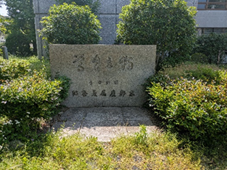Gravity(Attraction) of Kyoto Ⅳ Terakoya and post-Meiji Restoration Bangumi elementary schools
Yoshie Doi

Photo taken on May 20, 2025
Stone monument at the site of Keio Gijuku, Kyoto
East of the main gate of Kyoto Prefectural Government Office
Kyoto has had many terakoya schools since the Edo period, and at the end of the Edo period, Kyoto Prefecture had 566 terakoya schools and 34 private schools, far more than any other part of the country. According to the “Japanese Educational Materials,” there were between 15,000 and 20,000 terakoya schools nationwide.
Compared to other regions, Kyoto had many female teachers, and it was also characteristic of Kyoto that temple schools were opened at night for merchants. Even before the Meiji Restoration, there was a strong desire for education, and the entire city of Kyoto was involved in it.
Based on this history, in the Meiji period, each town’s self-governing organization built a Bangumi elementary school. To operate the school, an elementary school company was created, which provided loans and managed the funds. The amount of the funds was determined by the number of Kamado (stoves it’s named Okudosan in Kyoto), and the town association supported the elementary school, which not only served as a place of education, but also as a police station and fire station, and functioned as an administrative institution, so to speak.
More and more people donated each year, and some school districts even exempted students from paying tuition fees, using the interest from the donations to pay for their tuition. This shows the strong determination of Kyoto people to entrust the future of Kyoto to education. What is particularly noteworthy is that not only elementary school students, but adults also attended the school on set days of the week to learn about world affairs and other topics.
Although it is not widely known, Kyoto Keio Gijuku was established in February 1874 in a rented corner of the Kyoto Middle School classrooms in the former Kyoto Shugoshoku residence. It is located where the Kyoto Prefectural Office is now. The school was open for only one year, but it was closed due to difficulties in attracting students. There is a stone monument to the east of the guard room on the west side of the main gate of the Kyoto Prefectural Office.
Yukichi Fukuzawa visited Kyoto in May 1872 (Meiji 5) and highly praised the city’s education system in his “Kyoto Gakko no Ki” (Record of the Kyoto School). Kyoto is also home to many head temples of shrines and temples, and people from all over the country who came to Kyoto to train have a long history of acquiring etiquette, knowledge, and wisdom, and I believe this was put to good use in the field of education.
Kyoto is a city of tradition and history, but it has also been bold in its pioneering endeavors. Education has also been an advanced endeavor not seen in other cities, and Kyoto has attempted to revitalize itself after the Meiji Restoration.
The end of document
Translated by Masami Otani
